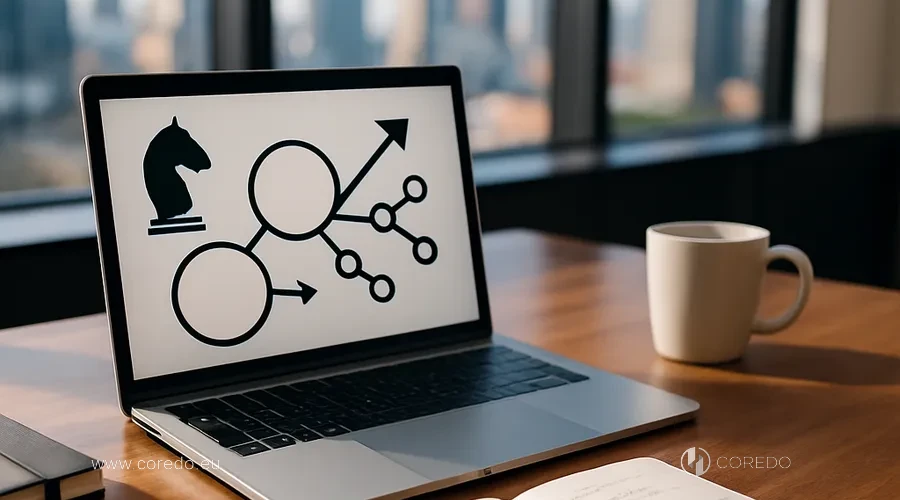Why do even experienced entrepreneurs and CFOs continue to lose millions to hidden risks despite due diligence and classic protection mechanisms? How to choose between Escrow and W&I insurance to not only close the deal but also protect the long-term interests of the business?
In this article I, Nikita Veremeev, share practical strategies for risk management in mergers and acquisitions based on COREDO’s experience in supporting M&A deals in the EU, Asia and the CIS. Here you will find not only a comparative analysis of Escrow and W&I insurance, but also concrete recommendations on deal structuring, legal risk management and choosing the optimal protection mechanism. Read the article to the end and you will get tools that really work in practice.
M&A trends in the EU, Asia and Africa
Since 2023 the M&A market in the EU and Asia has shown not only growth in deal volume but also increasing complexity of their structure. Complex deals involving multiple jurisdictions, the participation of private equity funds, and stricter disclosure requirements all bring risk management issues to the forefront. COREDO’s practice confirms: regulators in the EU and Singapore require increasingly detailed due diligence, while in Africa and the Middle East investors face unique legal and currency barriers.
The impact of jurisdiction on the choice of protection mechanism becomes key: while in the United Kingdom and Germany W&I insurance has become the standard for deals from €10 mln, in the Czech Republic and Estonia there remains a high share of Escrow accounts. Scaling M&A processes is another challenge: when closing deals simultaneously in multiple countries, unification of procedures, coordination of disclosure schedules and management of post-closing risks across different legal platforms is required.
Escrow в M&A – что это такое?

The solution developed at COREDO for cross-border deals involves using escrow agents licensed in the EU or the United Kingdom, which ensures transparency, control over funds and minimizes disputes over price adjustments.
Unlike direct warranties, Escrow does not cover all legal risks but remains in demand in jurisdictions with a limited W&I insurance market or in deals with a high share of non-obvious risks (hidden liabilities). It is important to consider: the escrow structure, the terms of fund blocking, the conditions for their release and the distribution of interest require detailed elaboration and agreement between the parties.
Escrow account in international deals – how it works
COREDO’s practice shows that in the EU and Asia opening an escrow account requires not only standard KYC but also the coordination of a package of documents, including the purchase agreement, escrow agreement, disclosure schedules and corporate resolutions. In Singapore and the United Kingdom, the escrow agent is obliged to comply with AML requirements and ensure the confidentiality of information about the parties to the deal.
Among the limitations – the impossibility of using Escrow to cover all types of post-closing risks, the difficulty of recovering funds in a dispute and differences in the regulation of escrow agents in different countries. For example, in the Czech Republic escrow accounts can only be opened in banks, while in Estonia — through licensed financial intermediaries. It is important to determine in advance the mechanism for claim settlement and the procedure for disclosing information to release funds.
Pros and cons of Escrow for the seller and the buyer
An escrow account provides the buyer with basic protection: funds do not transfer to the seller until key risks are remedied or due diligence is completed. For the seller, it is a limitation of liability and the opportunity to accelerate closing the deal by agreeing a minimum blocking period. However, hidden costs, escrow agent fees, bank charges, and legal support expenses can significantly reduce ROI, especially in small deals.
From COREDO’s experience: in a deal to acquire a fintech company in Estonia, the use of Escrow reduced reputational risks for both parties but required a separate agreement on the distribution of interest on the account and a clear procedure for adjusting the purchase price. For the seller, Escrow is a tool for managing claims work and minimizing the risk of long disputes, but not a panacea for all types of losses.
When choosing Escrow it is important to consider not only the advantages of its use but also the possibility of integrating additional risk management methods, such as W&I insurance – a tool to protect the parties to a deal from financial losses related to breaches of warranties and obligations.
W&I страхование в M&A, что это такое?

The insurance policy covers the buyer’s (or seller’s) losses in the event of warranty breaches, the discovery of hidden liabilities or errors in the disclosure schedules.
The COREDO team executed projects where W&I insurance substantially reduced negotiation time, increased the investment attractiveness of the target and minimized legal risks for both parties. Unlike Escrow, W&I covers a wide range of post-closing risks, including tax, employment, environmental and corporate liabilities.
Types of W&I insurance: buy-side and sell-side
There are two main types of W&I policies: buy-sideR&W policy (insurance for the buyer) and sell-side R&W policy (for the seller). Buy-side policy provides direct coverage of the buyer’s losses and becomes the standard for transactions involving funds and strategic investors. The sell-side policy is used less often, but allows the seller to limit their liability and increase deal transparency.
The impact of industry specifics on insurance terms is significant: for fintech and IT extended cyber-risk coverage is required, and for industrial assets: environmental liabilities. Allocation of risks between the parties, coverage limits, the deductible (excess/deductible) and the policy term are discussed individually and recorded in the insurance contract.
How to settle W&I claims
Obtaining W&I insurance requires thorough due diligence, preparation of disclosure schedules and disclosure of all material information about the target company. Insurance brokers (Lloyd’s, Howden) play a key role in negotiating coverage terms, determining limits and the deductible, and in organizing claims handling.
Claim settlement difficulties arise from insufficient disclosure, disputed interpretations of warranties or attempts to minimize losses after closing. COREDO’s practice shows: timely engagement with legal advisers, clear documentation of insurance coverage terms and transparency of disclosure schedules significantly accelerate W&I policy payouts (typically 3–6 months versus 12–18 months for Escrow).
Cost of W&I insurance for M&A
The cost of W&I insurance for M&A depends on deal size, industry, jurisdiction and the level of disclosure. On average the premium is 1–2% of the coverage amount, the deductible is 0.5–1% of the purchase price. For large transactions the ROI of W&I insurance is higher than Escrow: the insurance policy allows funds to be released immediately after closing, reduces the need for large Escrow amounts and increases company value by minimizing legal risks.
In COREDO projects for clients from the EU and Singapore W&I insurance helped optimize tax consequences, improve the financial stability of the parties and use the insurance policy as an argument when adjusting the purchase price. Performance metrics include not only direct savings on fees, but also a reduced likelihood of litigation, faster integration and increased investment attractiveness of the target.
Escrow or W&I: which to choose?

The choice between Escrow and W&I insurance is a strategic decision that affects deal structure, risk allocation and the final business valuation. Escrow provides basic protection but limits coverage to the amount in the account and does not protect against all types of post-closing risks. W&I insurance covers a wide range of liabilities, speeds up closing and minimizes long-term consequences for both parties.
Comparison of Escrow and W&I insurance
| Parameter | Escrow account | W&I insurance |
|---|---|---|
| Risk coverage | Limited | Extended |
| Speed of access to funds | Delay until settlement | Quick access after closing |
| Claim review period | Lengthy | Faster |
| Cost | Fixed fees | Insurance premium, deductible |
| Confidentiality | Medium | High |
| ROI | Depends on the volume of disputes | Higher for large transactions |
Escrow or W&I insurance when buying a business
COREDO’s practice confirms: the choice of mechanism depends on jurisdiction, deal size, industry and the parties’ structure. In the EU and the UK for transactions above €10 million W&I insurance becomes the optimal solution, especially when investment funds are involved. In Asia and Africa, where the W&I market is still developing, Escrow remains relevant but requires detailed drafting of terms and consideration of local regulatory specifics.
selection criteria include: availability of licensed insurance brokers, disclosure requirements, industry specifics, the possibility of combining mechanisms (for example, Escrow to cover non-insurable risks and W&I for key warranties). In complex cross-jurisdictional deals the COREDO team recommends using both instruments to maximize protection of the parties’ interests.
Practical tips for business

Practical tips for business not only reduce risks when concluding complex transactions, but also increase transparency and protection of all parties’ interests. Using tools such as escrow accounts and specialized insurance (W&I) becomes an important part of effective deal structuring and minimization of financial and legal risks.
How to structure a deal with Escrow and W&I
- Conduct thorough due diligence taking into account all jurisdictions and industry specifics.
- Identify the list of risks requiring coverage: hidden liabilities, tax, employment, environmental and corporate risks.
- Agree on the deal structure: the size and term of the Escrow, limits and terms of W&I insurance, adjustment of the purchase price.
- Prepare disclosure schedules and ensure transparency of information for the insurance broker and the escrow agent.
- Implement process automation: use digital platforms to monitor fulfillment of deal conditions and control funds in the Escrow account.
- Record in the contract the procedure for claim settlement, allocation of costs and the dispute resolution mechanism.
Typical SEO mistakes and how to avoid them
- Underestimating disclosure requirements for W&I insurance may lead to denial of payment under the policy.
- Using Escrow without a clear dispute resolution procedure delays the return of funds and reduces trust between the parties.
- Ignoring industry specifics leads to incomplete risk coverage.
- Lack of transparency in the work of the escrow agent and the insurance broker creates additional reputa
- Legal and financial risks.
- Incorrect ROI calculation – does not take into account hidden Escrow costs and tax consequences of W&I insurance.
All of the listed mistakes significantly complicate an objective assessment of the effectiveness of protection mechanisms in M&A transactions; below we will consider the main metrics for analyzing performance.
Key metrics for assessing effectiveness
- Share of covered risks (coverage ratio) compared to the total volume of liabilities.
- Timeframes for reviewing and settling claims.
- Final transaction cost including fees, insurance premiums, and tax consequences.
- ROI from using the chosen protection mechanism.
- Impact on the investment attractiveness of the target of the transaction and the financial stability of the parties.
Conclusions and recommendations

Modern M&A transactions require integrating Escrow and W&I insurance as complementary risk management tools. COREDO’s experience shows: competent legal support, process transparency, automation, and an individual approach to deal structure make it possible to minimize legal and financial risks, accelerate closing and increase the long-term value of the business.
Only in this way can you ensure strategic advantages, transparency and control at all stages of an M&A transaction – and make your business truly protected in any jurisdiction.